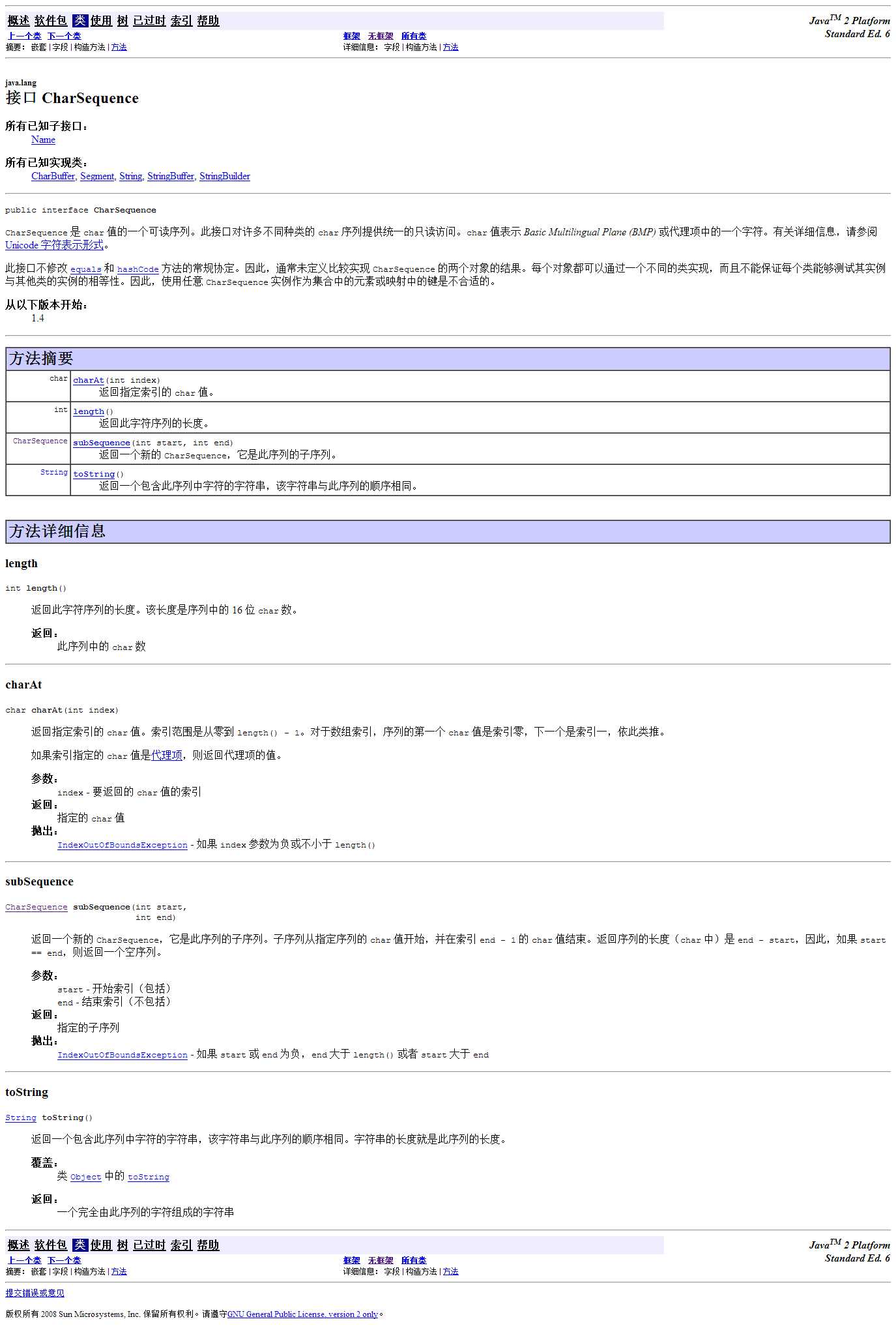标签:
我也不知道看源码有什么用,只是喜欢去看看...
java.lang.CharSequence
CharSequence是char值的一个可读序列。此接口对许多不同种类的char序列提供统一的只读访问.
CharSequence是一个接口,里面有4个方法,分别为:
public interface CharSequence{
//功能 : 返回此字符序列的长度
int length();
//功能 : 返回指定索引的char值
char charAt(int index);
//功能 : 返回一个新的CharSequence,它是此序列的子序列
CharSequence subSequence(int start,int end);
//功能 : 返回一个包含此序列中字符的字符串,该字符串与此序列相同
public String toString();
}
源代码如下:
package java.lang;
/**
* A <tt>CharSequence</tt> is a readable sequence of <code>char</code> values. This
* interface provides uniform, read-only access to many different kinds of
* <code>char</code> sequences.
* A <code>char</code> value represents a character in the <i>Basic
* Multilingual Plane (BMP)</i> or a surrogate. Refer to <a
* href="Character.html#unicode">Unicode Character Representation</a> for details.
*
* <p> This interface does not refine the general contracts of the {@link
* java.lang.Object#equals(java.lang.Object) equals} and {@link
* java.lang.Object#hashCode() hashCode} methods. The result of comparing two
* objects that implement <tt>CharSequence</tt> is therefore, in general,
* undefined. Each object may be implemented by a different class, and there
* is no guarantee that each class will be capable of testing its instances
* for equality with those of the other. It is therefore inappropriate to use
* arbitrary <tt>CharSequence</tt> instances as elements in a set or as keys in
* a map. </p>
* @since 1.4
*/
public interface CharSequence {
/**
* Returns the length of this character sequence. The length is the number
* of 16-bit <code>char</code>s in the sequence.</p>
*
* @return the number of <code>char</code>s in this sequence
*/
int length();
/**
* Returns the <code>char</code> value at the specified index. An index ranges from zero
* to <tt>length() - 1</tt>. The first <code>char</code> value of the sequence is at
* index zero, the next at index one, and so on, as for array
* indexing. </p>
*
* <p>If the <code>char</code> value specified by the index is a
* <a href="{@docRoot}/java/lang/Character.html#unicode">surrogate</a>, the surrogate
* value is returned.
*
* @param index the index of the <code>char</code> value to be returned
*
* @return the specified <code>char</code> value
*
* @throws IndexOutOfBoundsException
* if the <tt>index</tt> argument is negative or not less than
* <tt>length()</tt>
*/
char charAt(int index);
/**
* Returns a new <code>CharSequence</code> that is a subsequence of this sequence.
* The subsequence starts with the <code>char</code> value at the specified index and
* ends with the <code>char</code> value at index <tt>end - 1</tt>. The length
* (in <code>char</code>s) of the
* returned sequence is <tt>end - start</tt>, so if <tt>start == end</tt>
* then an empty sequence is returned. </p>
*
* @param start the start index, inclusive
* @param end the end index, exclusive
*
* @return the specified subsequence
*
* @throws IndexOutOfBoundsException
* if <tt>start</tt> or <tt>end</tt> are negative,
* if <tt>end</tt> is greater than <tt>length()</tt>,
* or if <tt>start</tt> is greater than <tt>end</tt>
*/
CharSequence subSequence(int start, int end);
/**
* Returns a string containing the characters in this sequence in the same
* order as this sequence. The length of the string will be the length of
* this sequence. </p>
*
* @return a string consisting of exactly this sequence of characters
*/
public String toString();
}

java源码(1) -- java.lang.CharSequence
标签:
原文地址:http://www.cnblogs.com/xinhuaxuan/p/5116154.html